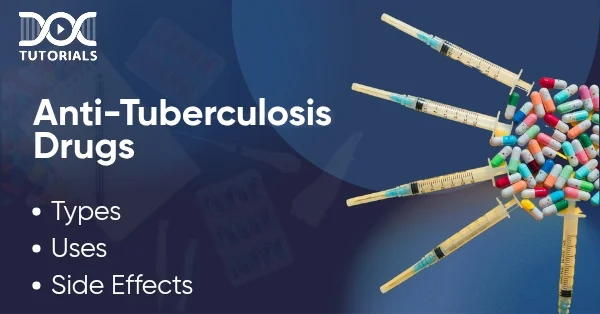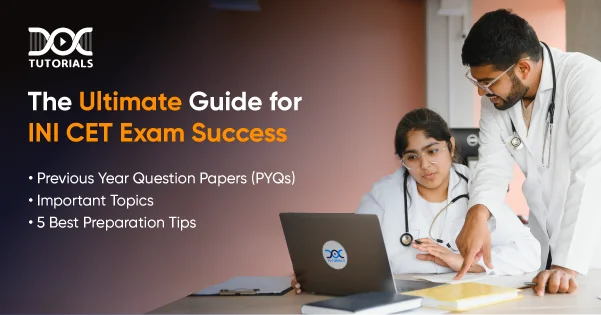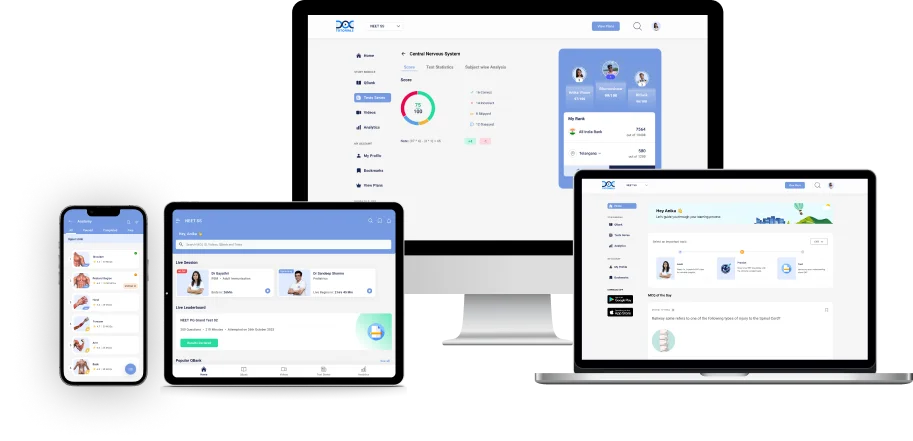What are the Precautions and Drug Interactions for Anti-Tuberculosis Drugs?

Anti-tuberculosis (anti-TB) drugs treat tuberculosis (TB), a contagious disease spread by Mycobacterium tuberculosis. TB usually affects the lungs; however, it can also damage other organ systems.
NEET PG students need to understand the different kinds of anti-tuberculosis drugs, what they treat, and their side effects. DocTutorials offers a structured learning plan with a complete syllabus and tools you can interact with, which helps aspiring medical students get a solid grip on pharmacology.
Keep reading to learn everything about anti-tuberculosis drugs and more details.
What are Anti-Tuberculosis Drugs?
Anti-Tuberculosis drugs are given by prescription. These drugs are specifically used to kill Mycobacterium tuberculosis bacteria. These drugs attack the bacteria in a few ways, such as:
- The drugs stop bacteria from synthesising proteins.
- They disrupt the bacteria’s cell wall formation.
- They block bacteria from replicating their DNA.
Treatment typically involves multiple anti-tuberculosis drugs taken simultaneously for six to nine months to ensure the bacteria are rendered completely non-viable, which also helps prevent drug resistance.
The activity of an anti-tuberculosis drug requires it to penetrate infected tissue and maintain appropriate concentrations for a lengthy period. Tuberculosis bacteria divide slowly and can remain dormant, meaning it is crucial to use combinations of drugs that target different dimensions of bacterial metabolism and survival.
What are the Types of Anti-Tuberculosis Drugs?
Tuberculosis medication relies on 2 categories of drugs: first-line (primary therapy) and second-line (for resistant cases). Each class has distinct roles, efficacy, and safety profiles.
Listed below are the categories in detail:
- First-Line Anti-Tuberculosis Drugs
First-line drugs are highly effective with minimal toxicity. The following drugs form the backbone of standard TB treatment regimens:
- Isoniazid: It disrupts bacterial cell walls by inhibiting mycolic acid synthesis. It is usually given at a regular dosage of 5 mg/kg daily (a maximum of 300 mg). Common side effects include hepatotoxicity and peripheral neuropathy.
- Rifampicin: It blocks RNA polymerase, preventing bacterial transcription, at a regular dosage of 10 mg/kg daily (max 600 mg). It may cause orange bodily fluids and drug interactions.
- Pyrazinamide: This drug is effective in acidic environments, targeting dormant bacilli with a regular dosage of 25 mg/kg daily. However, it is linked to hyperuricemia and hepatotoxicity.
- Ethambutol: It inhibits cell wall synthesis at a dosage of 15 mg/kg daily. This drug has the risk of optic neuropathy.
- Streptomycin: This is an injectable antibiotic that interferes with protein synthesis. It is used in specific situations, such as TB meningitis.
- Second-Line Anti-Tuberculosis Drugs
Used for drug-resistant TB, second-line drugs are less effective and more toxic, such as:
- Fluoroquinolones (e.g., moxifloxacin) inhibit DNA gyrase, with a pooled adverse event rate of 3.2–4.5%.
- Injectable agents (e.g., amikacin) cause ototoxicity and nephrotoxicity.
- Linezolid treats extensively drug-resistant TB but has high toxicity (59% side effects)
What are the Uses of Anti-Tuberculosis Drugs?
Anti-tuberculosis treatment is chosen based on the severity of the disease and whether the bacteria are resistant to any drugs. For drug-sensitive TB, the standard treatment regimen lasts 6 months and is divided into 2 phases:
- Intensive Phase (First 2 months): The patient is given four medicines — Isoniazid, Rifampicin, Pyrazinamide, and Ethambutol. These drugs work together to quickly reduce the number of TB bacteria in the body.
- Continuation Phase (Next 4 months): The patient continues with Isoniazid and Rifampicin to destroy remaining TB bacteria completely.
Shorter treatment regimens are available for latent TB (when a person is infected but does not have active disease). One common option is a three-month course of weekly Isoniazid and Rifapentine.
Treatment for drug-resistant TB can become more complex and last 18 to 24 months. Depending on the resistance pattern, these cases require second-line drugs, which may include Bedaquiline and Fluoroquinolones. These medications are used because the usual first-line drugs no longer work against the resistant TB bacteria in this condition.
What are the Side Effects of Anti-Tuberculosis Drugs? Management
Anti-tuberculosis drugs cause diverse adverse effects, impacting treatment adherence. Early recognition and management are crucial. Common side effects of these drugs are:
- Gastrointestinal Side Effects: Nausea, vomiting, diarrhoea.
- Neurological Side Effects: Peripheral neuropathy (isoniazid), dizziness.
- Dermatological Side Effects: Rashes, itching.
A few of the severe adverse reactions may also include:
- Hepatotoxicity: Elevated liver enzymes (9.2/1000 cases with isoniazid).
- Optic Neuropathy: Ethambutol-induced vision changes.
- Hypersensitivity: Fever, anaphylaxis (rare).
How to Manage the Side Effects of Anti-Tuberculosis Drugs?
A few of the most effective management strategies for the side effects of anti-tuberculosis drugs include:
- Monitor liver/kidney function baseline and periodically.
- Administer pyridoxine (vitamin B6) to prevent neuropathy with isoniazid.
- Adjust doses or switch drugs for severe toxicity.
What are the Precautions and Drug Interactions for Anti-Tuberculosis Drugs?
Anti-TB drugs require careful monitoring in high-risk patients (e.g., HIV, liver disease). Key considerations include:
- Rifampicin: Induces CYP450 (Cytochrome P450) enzymes, reducing efficacy of antiretrovirals, antifungals, and contraceptives.
- Isoniazid: Avoid alcohol to prevent hepatotoxicity.
- Ethambutol: Monthly vision tests for long-term use.
FAQs About Anti-Tuberculosis Drugs
- What are the main drugs used to treat tuberculosis?
The main drugs used to treat tuberculosis are Isoniazid, Rifampicin, Pyrazinamide, and Ethambutol, which are primarily given in combination.
- What are the side effects of TB drugs?
Common side effects of TB drugs include nausea, loss of appetite, liver toxicity, skin rashes, joint pain, and vision problems, especially with Ethambutol. However, not every patient might experience side effects of these drugs.
- What is drug-resistant TB?
Drug-resistant TB occurs when the tuberculosis bacteria no longer respond to the standard first-line medications. This condition happens due to irregular or incomplete treatment.
- Why is it important to take TB medicines regularly for the entire duration of the prescribed course?
It is important to take TB medicines regularly and for the full duration to eliminate the bacteria, prevent relapse, and avoid the development of drug resistance.
- For how long must tuberculosis treatment be taken?
Tuberculosis treatment usually lasts for 6 months, but it can be longer depending on the type of TB and the patient’s response to the therapy.
Conclusion
Anti-tubercular drugs play a vital role in controlling TB. However, treatment must be complied with, regulated, and individualised to different patients to be effective. First-line drugs have shown excellent cure rates, while second-line regimens have been employed in fighting resistance, but at the cost of increased toxicity.
If practitioners understand the mechanisms of action, uses, side effects, and interactions of these drugs, they will contribute to optimising outcomes and impact the global burden of TB.
At DocTutorials, we provide students with detailed NEET PG study material on Pharmacology. With our systematic approach and expert coaching, aspiring medical students can become successful doctors with an exceptional understanding of the medical profession.
Latest Blogs
-

NEET PG Exam 2025- Date, Pattern, Marking Scheme, Subject Wise Weightage, and Exam Mode
NEET PG Exam 2025 is the ultimate gateway for medical graduates aspiring to pursue postgraduate courses in medicine, including MD,…
-

INI CET Exam 2025: Your Roadmap to Success – Key Topics, Strategies, and Lessons from Last Year’s Papers
The INI CET exam is more than just a test; it’s a significant milestone for many medical students aiming to…
-

INI CET Exam Success: Previous Year Question Papers & Ultimate Guide – INI CET PYQ
One can feel overwhelmed while preparing for the INI CET (Institute of National Importance Combined Entrance Test). A vast syllabus,…




